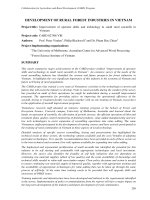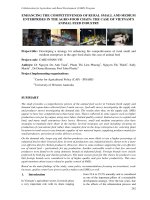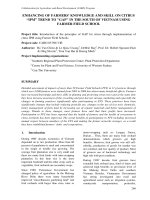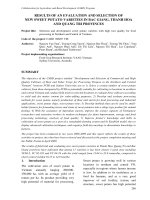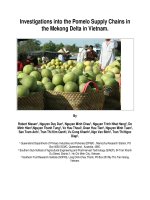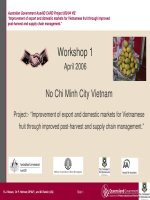Báo cáo nghiên cứu nông nghiệp " Selection and development sweet potato varieties with high root quality for food processing in Northern and Central of Vietnam " potx
Bạn đang xem bản rút gọn của tài liệu. Xem và tải ngay bản đầy đủ của tài liệu tại đây (13.98 MB, 9 trang )
Collaboration for Agriculture and Rural Development
(CARD)
Program
288
RESULTS OF AN EVALUATION AND SELECTION OF
NEW SWEET POTATO VARIETIES IN BAC GIANG, THANH HOA
AND QUANG TRI PROVINCES
Project title:
Selection and development sweet potato varieties with high root quality for food
processing in Northern and Central of
Vietnam
Code of the project
: CARD 008/07 VIE
Author(s):
Nguyen Van Tuat
1
, Truong Cong Tuyen
1
, Nguyen Dat Thoai
1
, Truong Thi Thuy
1
, Tran
Quoc Anh
1
, Nguyen Phan Anh
1
, Do Thi Lieu
1
, Nguyen Thi Hoai
1
, Les Copeland
2
,
Peter Sharp
2
, and Richard Trethowan
2
P
roject implementing organizations:
Food Crop Research Institute, VAAS, Vietnam
Sydney University, Australia
SUMMARY
The objectives of the CARD project entitled “Development and Selection of Commercial and High
Quality Cultivars of Root and Tuber Crops for
Processing Purpose in the Northern and Central
Vietnam” between FCRI and Sydney University are to 1) Select a certain number of sweet potato
cultivars from those designated by FCRI as potentially suitable for cultivating in locations in northern
and centr
al Vietnam and conduct field trials in selected locations to evaluate these cultivars according
to yield and dry matter content for value
-
adding purposes; 2) Develop and evaluate processing
methods for sweet potato, namely production of flour and starch fo
r food processing and industrial
applications, sweet potato chips, sweet potato wine; 3) Develop methods that can be used by small
-
holder farmers for fermenting leaves and stems of sweet potatoes into a silage
-
type product for animal
feeding; 4) With the a
ssistance of Australian experts, improve the science capacity of Vietnamese
researchers and extension workers in modern techniques for plant improvement, storage and food
processing technology, analysis of food quality; 5) Improve farmer’s knowledge and sk
ills in
cultivation of sweet potato as a part of a sustainable farming system and 6) Establish model sites to
display advanced cultivation techniques, and organize field day meetings to disseminate knowledge to
farmers.
The project has been conducted in tw
o years 2008
-
2009 and this report reflects the results of those
activities in project sites that have been reviewed and discussed at the project completion meeting and
the Public Forum in April 2009.
The results of field trial and evaluating new sweet pota
to varieties in Thanh Hoa, Quang Tri and Bac
Giang provinces have indicated that among 11 varieties it has been chosen 3 good ones including
VC68
-
2, VC 02
-
193 and VC 04
-
24 with the yield ranged from 13.64 to 23.6 tonnes/ha, compared to
check control yielde
d 10.13 to 14.9 tone/ha
1.
Introduction
The cultivation area of sweet potato in
Vietnam annually ranging 200,000
-
250,000 ha, with an average yield of 8
ton
nes
per ha. Its product providing very
high potential of material for processing.
Sweet potato is g
rowing well in various
locations in northern and central VN,
especially in regions where farmer income
is low. In addition to its usefulness as a
food for humans, and as a very good
improver of soil fertility, texture and
structure, sweet potato has high p
otential
CARD 008/07 VIE
–
Development of sweet potato varieties with high quality
289
for value adding and as a source of feed for
animals from the unharvested parts. Using
this crop can reduce the risk of major pests
and diseases of other crops like rice and
vegetables, thereby better protecting the
agricultural environment. There
is a market
for products from tuber crops such as
sweet potato, for example flour and starch
as a raw material for industry in the
manufacture of foods, confectionery,
pharmaceuticals, paper and textiles. The
demand of starch for industry in Vietnam
annua
lly is about one million tons, much of
which is imported. The lack of good
cultivars and relevant technology for
cultivation and processing of sweet potato
means that this crop is not achieving its
great potential for contributing to
increasing income and
providing
socioeconomic benefits for farmers in
poorer regions. At FCRI, several sweet
potato cultivars, such as sweet potato No.8,
KB1, KL5, K4, K51, Advance 1, Advance
2 and Hoang Long, have been identified
for their agronomic and adaptive traits,
resist
ance to key insect pests and diseases,
and nutrient requirements. However, these
cultivars have not been evaluated for yield
and dry matter production and
performance in processing. The central
region and some northern provinces of
Vietnam have suitable gr
owing seasons for
tuber crops. The cultivation of sweet
potato crops in these regions needs to be
investigated as part of a sustainable
cropping system that increases farmer
income. In this paper the research results
conducted from 2008
-
2009 of the CARD
pr
oject
"Selection and development sweet
potato varieties with high root quality for
food processing in Northern and Central of
Vietnam
” are highlighted.
2.
Research contents and methods
2
.1
Materials
Ten varieties were collected from Food Crops
Research In
stitute, Hoang Long and local
sweet potato varieties were used as the check
varieties.
2
.2
Project sites
-
Food Crops Research Institute
experiment farm
-
Bac Giang province (Bich Son
-
Viet
Yen, Ngoc Chau
-
Tan Yen, Mai Trung
-
Hiep Hoa)
-
Thanh Hoa province (Nguyên
Binh
-
Tinh
Gia, Quang Luu
-
Quang Xuong, Dong
Thanh
-
Dong Son)
-
Quang Tri province (Vinh Thai
-
Vinh
Linh, Gio Hai
-
Gio Linh, Hai Quy
-
Hai
Lang)
2.3
Research content
-
Evaluate and select new potato varieties
in Bac Giang and Thanh Hoa based on
quality and yield
-
Evaluate and select new potato varieties
at FCRI based on quality and yield
-
Evaluate and select new potato varieties
in Quang Tri based on quality and yield
2.4
Methodology
Experiment type
-
R
andomized complete block design
(RCBD
)
-
Study area: 11 varieties x 4
replications x 15 m
2
= 660 m
2
-
Protection area: 340 m
2
-
Total area for one experiment = 1,000
m
2
Planting method
-
Cut and plant sweet potato root with
the clean
tools in all of the locations.
-
Distance: the distance between two
plants in a row was 0.2 m and the
density was 40,000 plants/ha
-
Align the plant vertically to the bed
surface
Planting time:
-
Thanh Hoa and Bac Giang: 5
-
10th
October
-
Quang
Tri:
15
-
20th Dece
mber
NV
Tuat,
TC Tuyen
, N
D
Thoai,
TT
Thuy,
TQ
Anh,
NP
Anh,
DT
Lieu,
NT
Hoai,
L
.
Copeland, P
.
Sharp
&
R
.
Trethowan
290
Fertilization application
Fertilizer
K
g /ha
Kg
(NPK)/ha
Cattle manure
15,000
-
Urea
150
60
-
70 kg N/ha
Super
Phosphate
550
90
-
100
kg
P/ha
Kali
220
120 kg K/ha
-
Mix all of the cattle manure and super
phosphate as well as 30% of urea and
30% of
potassium for treatment
before planting.
-
Half of the remaining Urea and Kali
fertilizers were fertilized 20
-
25 days
after planting. The other half was
added in 40 to 45 days after planting.
Harvesting data collection
-
For each treatment, sweet potato roo
ts
were harvested from 4 m long section
in the middle of the bed.
-
Sweet potato roots were inspected
with criteria such as insects, diseases,
breakage for each treatment.
-
Counting the number of roots for each
treatment.
-
Weighing and grading roots: smal
l
<30g, medium 30
-
50g, large >100g.
Statistic analysis
Data were collected by the Vietnamese
participants and analysed statistically
by the Australian experts.
3.
Research results and discussions
3.1
Evaluate and select new potato
varieties in Bac Gia
ng and Thanh Hoa
based on quality and yield
The dry matter contents were determined for
roots of the sweet potato varieties at all of
locations in Bac Giang and Thanh Hoa, 2008
(Table 1). The highest dry matter content in
these sweet potato varieties were
25.65% of
HT2 and 25.38% of VC01. The values were
much higher than those of Hoang Long
(21.29%) and the local (20.49%). On the other
hand, in the same varieties, the dry matter
content in a location was different between
locations. For example, HT2 had hig
h dry
matter content of 33.5% and 30.73% in S2 and
S6, respectively but only 24.6% and 18.57% in
S1 and S3, respectively. Therefore, varieties
and environment caused different dry matter
content of these sweet potato roots. The main
factor was the winter
in Bac Giang (S1) and
Thanh Hoa (S3) influencing unfavourably dry
matter content.
Table 1:
Dry matter content (%) in root of Sweet potato varieties in Winter season
2008
Sites
Variety
S1
S2
S3
S4
S5
S6
Mean
KL5
20.13
20.63
19.17
20.97
18.
9
20.2
20.00
KB1
18.63
26.17
19.9
21.73
19.77
23.97
21.70
S
ố
8
23.37
27.87
19.50
21.23
23.83
22.47
23.05
HT2
24.6
33.50
18.57
21.37
25.10
30.73
25.65
TM1
22.5
23.70
19.07
20.87
18.67
18.20
20.50
VC.01
27.53
29.10
19.13
23.00
27.13
26.40
25.38
VC.68
-
2
23.57
26.13
18.90
22.43
25.23
20.23
22.75
VC.97
-
6
-
3
24.1
2
0.67
18.97
22.77
20.67
20.50
21.28
VC 04
-
24
20.33
27.20
19.33
18.87
18.20
20.90
20.81
VC02
-
193
20.13
28.63
18.83
21.93
20.87
18.80
21.53
Hoang Long
21.57
24.47
18.17
22.87
21.77
18.90
21.29
Local variety
20.23
21.73
19.20
19.83
20.73
21.23
20.49
Mean
22.22
25.82
19.06
21.49
21.74
21.88
22.03
LSD (5%)
3.317
3.969
1.651
1.904
2.34
3.056
CV%
8.8
9.1
5.1
5.2
6.4
8.2
Note:
S1= Bich Son
-
Viet Yen, Bac Giang
S2= Cao Xa, Tan Yen, Bac Giang
S3= Dong Quang, Dong Son, Thanh Hoa
S4= Mai Trung, Hiep Hoa,
Bac Giang
S5= Nguyen Binh, Tinh Gia, Thanh Hoa
S6= Quang Minh, Quang Xương, Thanh Hoa
-
Evaluation of root yield
:
Root yield
of the
new sweet potato varieties in Thanh Hoa and
Bac Giang is shown in Table 2
.
In general, all
of the root yields were lower t
han the expected
CARD 008/07 VIE
–
Development of sweet potato varieties with high quality
291
potential yields due to the unfavourable
weather in all locations. However, VC68
-
2,
VC04
-
24 and VC02
-
193 achieved higher root
yields of 13.75, 14.94 and 13.64 tonnes/ha,
respectively, than Hoang Long and the local
variety with 10.62 and 10
.13 tonnes/ha,
respectively. The location S1 had the highest
root yield of the six locations.
Table2:
Root yield (tonnes/ha) of sweet potato varieties in Winter 2008
Varieties
S1
S2
S3
S4
S5
S6
Mean
KL5
17.87
10.67
10.29
11.41
11.33
11.16
12.12
KB1
19.36
10.62
12.13
12.12
11.54
11.04
12.80
N
o
8
17.78
10.73
10.47
10.61
10.82
11.24
11.94
HT2
15.13
9.38
9.64
10.51
10.54
11.62
11.14
TM1
14.42
12.00
11.22
11.29
11.98
9.42
11.72
VC.01
14.89
10.36
9.73
10.64
8.87
9.04
10.59
VC.68
-
2
19.29
13.56
13.8
0
11.88
12.93
11.02
13.75
VC.97
-
6
-
3
15.89
13.00
9.93
11.32
10.76
10.27
11.86
VC 04
-
24
22.62
11.13
12.51
15.16
14.33
13.87
14.94
VC02
-
193
19.51
12.00
11.78
14.30
13.56
10.69
13.64
Hoang Long
18.40
8.82
7.84
9.93
10.13
8.60
10.62
Local variety
18.73
10.
16
7.00
7.68
7.80
9.40
10.13
Mean
17.82
11.04
10.53
11.40
11.22
10.62
12.10
LSD
1.87
1.28
2.68
0.70
0.76
1.83
CV%
6.20
6.90
15.00
3.60
4.00
10.20
Note:
S1= Bich Son
-
Viet Yen, Bac Giang
S2= Cao Xa, Tan Yen, Bac Giang
S3= Dong Quang, Dong Son, Th
anh Hoa
S4= Mai Trung, Hiep Hoa, Bac Giang
S5= Nguyen Binh, Tinh Gia, Thanh Hoa
S6= Quang Minh, Quang X
ương, Thanh Hoa
The dry matter content of vine
-
leaf of vine
-
leaves as shown in Table 3, varied from 10.62
to 12.22%. Most of the varieties had similar
values of dry matter content but N
o
8 had the
highest average dry matter content of 12.22%.
The dry matt
er content of vine
-
leaves in Bac
Giang (S2) and Thanh Hoa (S5) had high
values of 11.52 and 12.56%, respectively.
Table 3
.
Dry matter content (%) in vine
-
leaf of sweet potato varieties in Winter season 2008
Varieties
S1
S2
S3
S4
S5
S6
Mean
KL5
11
.50
11.14
11.19
9.92
11.70
10.72
11.03
KB1
9.87
11.15
10.83
10.54
11.92
9.41
10.62
N
o
8
12.97
12.05
12.13
11.82
13.61
10.733
12.22
HT2
11.75
11.19
12.01
11.42
13.10
11.74
11.87
TM1
10.10
11.51
11.90
11.08
12.56
9.52
11.00
VC.01
10.94
12.21
12.29
11.16
12.99
11.69
11.88
VC.68
-
2
12.90
8.75
10.28
10.34
11.36
10.74
10.73
VC.97
-
6
-
3
10.01
12.84
11.86
10.79
12.12
10.62
11.37
VC 04
-
24
10.03
12.57
11.33
9.24
11.31
10.10
10.76
VC02
-
193
9.54
11.31
11.30
11.25
13.23
9.37
11.00
Hoang Long
10.14
12.08
12.08
11.
89
13.51
10.64
11.72
Local variety
10.01
11.42
11.54
13.31
13.31
9.88
11.58
Mean
10.81
11.52
11.50
11.06
12.56
10.43
11.31
LSD
1.48
1.90
0.99
1.27
2.32
1.40
CV%
8.10
9.70
5.10
6.80
10.90
7.90
Note:
S1= Bich Son
-
Viet Yen, Bac Giang
S2= Cao Xa, Tan
Yen, Bac Giang
S3= Dong Quang, Dong Son, Thanh Hoa
S4= Mai Trung, Hiep Hoa, Bac Giang
S5= Nguyen Binh, Tinh Gia, Thanh Hoa
S6= Quang Minh, Quang Xương, Thanh Hoa
NV
Tuat,
TC Tuyen
, N
D
Thoai,
TT
Thuy,
TQ
Anh,
NP
Anh,
DT
Lieu,
NT
Hoai,
L
.
Copeland, P
.
Sharp
&
R
.
Trethowan
2
92
-
The vine
-
leaf yields
:
The vine
-
leaf yields of the
new varieties in Bac Giang and Than
h Hoa in the
winter season 2008 were calculated and presented
in Table 4.
-
The unfavourable climate in the winter of 2008
affected the growth of the sweet potato varieties
and reduced the vine
-
leaf yield. The highest
yield was only 8.01 tones/ha from TM1
while
Hoang Long and the local variety had very low
yields of 5.95 and 6.85 tonnes/ha, respectively.
-
In the same varieties, the vine
-
leaf yield in
various locations was different. Therefore,
evaluation of adaptability of a variety to the
environment is
necessary
.
Table 4:
Vine
-
leaf yield (tonnes/ha) of sweet potato in Winter season 2008
Varieties
S1
S2
S3
S4
S5
S6
Mean
KL5
8.36
3.71
6.51
8.69
10.83
3.36
6.91
KB1
7.87
3.24
4.31
8.37
10.16
3.24
6.20
N
o
8
8.71
3.91
4.96
8.60
11.23
3.71
6.85
HT2
6.7
8
4.60
6.16
7.85
10.02
4.60
6.67
TM1
8.27
4.80
6.89
9.83
13.58
4.69
8.01
VC.01
8.33
4.60
6.18
9.03
12.10
4.40
7.44
VC.68
-
2
7.02
4.64
2.44
9.48
12.66
4.64
6.82
VC.97
-
6
-
3
7.69
11.13
4.69
8.99
11.13
3.64
7.88
VC 04
-
24
10.64
3.64
5.40
9.06
11.45
3.42
7.27
VC02
-
193
9.60
4.84
5.64
9.42
11.67
4.84
7.67
Hoang Long
6.96
3.33
3.89
7.99
10.20
3.33
5.95
Local variety
8.38
3.62
6.49
8.09
10.88
3.62
6.85
Mean
8.22
4.67
5.30
8.78
11.32
3.96
7.04
LSD
1.33
1.52
1.38
0.86
1.21
1.37
CV%
9.50
19.20
15.40
5.80
6.30
20.50
Note:
S1= Bich Son
-
Viet Yen, Bac Giang
S2= Cao Xa, Tan Yen, Bac Giang
S3= Dong Quang, Dong Son, Thanh Hoa
S4= Mai Trung, Hiep Hoa, Bac Giang
S5= Nguyen Binh, Tinh Gia, Thanh Hoa
S6= Quang Minh, Quang X
ương, Thanh Hoa
3.2
Evaluate and select new potato
varieties at the FCRI’ farm
To compare with the other locations, these
sweet potato varieties were also planted in
Food Crops Research Institute. The criteria to
evaluate the quantity were also measure
d and
presented in the table 5 below that:
-
The vine
-
leaf yield of the varieties
was equal or lower than the one of
the Hoang Long variety (control).
-
The root yield is an important value
to be evaluated and selected a good
variety. VC04
-
24 and VC02
-
193
produced the root yields with 21.7
and 18.9 tonnes/ha much higher than
the control (Hoang Long) with only
11.1 tones/ha.
CARD 008/07 VIE
–
Development of sweet potato varieties with high quality
293
Table 5
.
Yields of sweet potato varieties studied at FCRI’ farm in 2008
Varieties
Vine
-
leaf
yield
(tonnes/ha)
Root yield
(ton
nes/ha)
R
oot
weight
(g)
Number
of root
per plant
(#)
Grade ratio
(%)
>100g
30
-
100g
<30g
KL5
9.8
17.3
65.7
6.6
45.5
23.3
31.2
KB1
8.6
12.1
47.2
6.4
39.5
25.8
34.6
No 8
9.6
14.0
74.3
4.7
33.9
25.3
40.8
HT2
12.2
13.1
59.5
5.6
40.4
27.8
31.8
TM1
10
.7
18.6
66.5
7.0
31.5
33.7
34.8
VC.01
10.7
15.3
69.4
5.5
39.8
36.5
23.8
VC.68
-
2
6.8
13.5
49.6
6.8
33.9
23.8
42.3
VC97
-
6
-
3
10.5
14.5
55.9
6.5
39.3
25.4
35.3
VC04
-
24
10.1
21.7
60.2
9.0
30.7
37.6
31.8
VC02
-
193
10.8
18.9
53.1
8.9
36.6
27.0
36.4
Hoang Lon
g
12.0
11.1
49.6
5.6
17.8
21.9
60.2
CV (%)
6.2
5.9
14.1
11.6
11.7
17.5
13.2
LSD0.05
1.28
1.28
14.2
1.10
5.97
7.0
6.97
Some quality criteria also were determined for
the sweet potato root from all the varieties. The
table 6 below presented that:
-
VC0
1 and VC68
-
2 achieved the highest
dry matter contents with 27.5
% and 26%,
respectively in all the varieties. These two
varieties had the highest softness with
score 5. These values of the varieties were
much higher than Hoang Long (the
control varieties).
-
Although VC04
-
24 and VC02
-
193 had
the highest yields, the sweetness scores
were only 4. It was concluded that that the
VC01 and VC68
-
2 gave highest quality
while VC04
-
24 and VC02
-
193 obtained
highest quantity.
Table 6
.
Yields, dry matter content, sens
ory value of sweet potato varieties in F
CRI
in Winter 2008
Varieties
RDMC
(
%)
RDMY
(tonnes/ha)
SLDMC
(%)
SLDMY
(tonnes/ha)
Sweetness
1
-
5*
Softness
1
-
5*
KL5
20.5
3.5
8.1
0.8
5
1
KB1
21.9
2.6
9.2
0.8
3
1
No8
22.5
3.2
10.0
1.0
3
3
HT2
25.6
3.2
9.7
1.2
3
4
TM1
21.7
3.8
9.6
1.0
3
1
VC.01
27.5
4.1
9.3
1.0
4
5
VC.68
-
2
26.0
3.5
9.3
0.6
2
5
VC97
-
6
-
3
22.6
3.3
9.5
1.0
4
1
VC04
-
24
19.0
4.1
7.2
0.7
4
1
VC02
-
193
23.9
4.5
9.3
1.0
4
1
Hoang Long
21.5
2.3
10.3
1.2
4
2
CV%
1.7
6.6
6.4
7.7
LSD 0.05
0.56
0.3
3
0.85
0.1
* Note:
-
RDMC= Root dry matter content
-
SLDMC= Vine
-
leaf dry matter content
-
RDMY =Root dry matter yield
-
SLDMY= Vine
-
leaf dry matter yield
-
1
-
5*: score 1= not soft, not sweet;
score 3= soft, relative sweet; score 5 = very soft,
very sweet
CARD 008/07 VIE
–
Development of sweet potato varieties with high quality
294
3.
3
Evaluate and select new potato
varieties at Quang Tri in Spring
season 2009
At Quang Tri, the sweet potato crop was
harvested in April 2009. The root, the vine and
leaves were taken to determine for the weight,
the yield and the other
quantity criteria (Table
7).
-
The vine
-
leaf yield of all sweet potato
varieties was improved very well.
Most of the varieties had relatively
high vine
-
leaf yield about 19.7
-
26.9
tones/ha. KL5 achieved with yield of
31.1 tonnes/ha, which was much
higher
than Hoang Long (control) with
19.9 tonnes/ha.
-
For the important criterion, the root
yield was high with 21.6 from VC04
-
24 and 23.6 tonnes/ha from VC02
-
193.
Hoang Long (control) and the local
variety had the lowest root yields of
16.6 and 14.9 tonnes/h
a, respectively.
Table 7
.
Yields of sweet potatoes in Quang Tri in the Spring Season 2009
Varieties
Vine
-
leaf
yield
(tonnes/ha)
Root
yield
(tonnes/
ha)
Average
root
weight
(g)
Number
of root
per plant
(#)
Grade ratio (%)
>100g
30
-
100g
<30g
KL5
3
1.1
19.3
106.9
4.5
28.5
36.2
35.3
KB1
22.5
19.6
98.9
4.9
31.5
35.9
32.7
No8
24.8
16.0
99.2
4.0
32.8
22.7
44.5
HT2
26.7
17.1
108.8
3.9
33.8
34.2
32.1
TM1
26.9
13.2
92.7
3.6
36.7
32.1
31.3
VC.01
28.7
10.6
74.5
3.6
39.7
40.0
20.3
VC68
-
2
19.7
18.9
106.8
4.4
36.5
32.8
30.7
VC.97
-
6
-
3
23.6
19.5
108.4
4.5
30.9
37.1
32.0
VC.04
-
24
23.4
21.6
122.2
4.4
28.6
38.2
33.2
VC.02
-
193
20.4
23.6
133.4
4.4
41.9
37.0
21.1
Hoang long
19.9
16.6
112.7
3.7
40.5
35.3
24.3
Local
23.6
14.9
107.1
3.5
40.4
33.4
26.2
CV(%)
3.0
4.3
8.3
8.6
-
-
-
LSD 0.05
1.2
1.3
14.7
0.6
-
-
-
The quality criteria of dry matter content and
yield of root and vine
-
leaf, the sweetness and
softness of root were also determined for all
sweet potato varieties planted in Quang Tri at
the spring seas
on 2009 (Table 8).
-
In Quang Tri, all the varieties had high
dry matter contents from 27.6
-
35.2%.
There were 8 varieties with the dry
matter content over 30% in which HT2
and VC01 achieved the highest contents
with 34.7 and 35.2%, respectively. In
additi
on, the VC01 also obtained the
highest dry matter yield with 4.0
tonnes/ha.
-
VC01 and VC68
-
2 had the best softness
with score 5 which was much higher
than the scores of Hoang Long with 2
and the local with 1.
-
KL5 and Local had the best sweetness
with
score 5 which was higher than the
scores of Hoang Long with 4.
The sweet potato varieties planted in the sandy
soil along the coast, Quang Tri province also
provided very high dry matter of root and vine
-
leaf.
CARD 008/07 VIE
–
Development of sweet potato varieties with high quality
295
Table 8
.
Yields, dry matter content, sensor
y value of sweet potato varieties in
Quang Tri (Spring
season 2009)
Varieties
RDMC
(
%)
RDMY
(tonnes/ha)
SLDMC
(%)
SLDMY
(tonnes/ha)
Sweetness
1
-
5*
Softness
1
-
5*
KL5
27.6
3.9
12.8
5.3
5
1
KB1
29.3
2.7
12.0
5.7
3
1
N 8
31.4
3.4
13.8
5.0
3
3
HT2
34.7
3.
5
13.1
5.9
3
4
TM1
28.7
3.6
13.3
3.8
3
1
VC.01
35.2
4.0
14.0
3.7
4
5
VC68
-
2
30.6
2.7
13.8
5.7
2
5
VC.97
-
6
-
3
31.2
3.1
13.1
6.1
4
1
VC.04
-
24
28.0
3.5
14.7
6.0
4
1
VC.02
-
193
30.9
2.7
13.2
7.2
4
1
Hoang long
33.3
2.8
14.2
5.5
4
2
Local
30.2
3.0
13.0
4.
5
5
1
CV(%)
3.2
4.6
4.0
5.3
-
-
LSD(0.05)
1.6
0.3
0.9
0.4
-
-
* Note:
-
RDMC= Root dry matter content
-
SLDMC= Vine
-
leaf dry matter content
-
RDMY =Root dry matter yield
-
SLDMY= Vine
-
leaf dry matter yield
-
1
-
5*: score 1= not soft, not sweet;
s
core 3= soft, relative sweet; score 5 = very soft, very sweet
Figure
1
.
New potential varieties of sweetpotato VC02
-
193 (left), VC68
-
2 (centre), VC04
-
24 (right
)
4.
Conclusions and recommendation
s
4.1
Conclusions
-
In Bac Giang and Thanh Hoa p
rovinces, low
temperatures and the short sunshine period of
the winter season 2008 impacted negatively
on the yields of vine
-
leaf and root of all sweet
potato varieties at the locations. The varieties
VC68
-
2, VC04
-
24 and VC02
-
193 have
achieved the best roo
t yields of 13.75, 14.94
and 13.64 tonnes/ha, respectively, which was
higher than those of Hoang Long and the
local check variety.
-
At the FCRI’s experiment station the
varieties VC04
-
24 and VC02
-
193 have
produced the highest root yields with 21.7
and
18.9 tonnes/ha while VC01 and VC68
-
2
provided the best sweetness and softness.
-
In Quang Tri province, the varieties VC04
-
24
and VC02
-
193 have obtained the highest root
yield with 21.6 and 23.6 tonnes/ha,
respectively. The highest dry matter contents
we
re found in HT2 and VC01 with 34.7 and
35.2%, respectively. The VC01 and VC68
-
2
had the best quality criteria about sweetness
and softness.
NV
Tuat,
TC Tuyen
, N
D
Thoai,
TT
Thuy,
TQ
Anh,
NP
Anh,
DT
Lieu,
NT
Hoai,
L
.
Copeland, P
.
Sharp
&
R
.
Trethowan
296
4.2
Recommendations
Variety VC68
-
2 should be further improved
for quality trait and VC04
-
24 and VC02
-
193
for high
yield in order to introduce new sweet
potato varieties for growing in Bac Giang,
Thanh Hoa and Quang Tri provinces in the
future.
References
1. Đinh The Loc,
Sweet potato and cultivation
technology
. Agriculture Publishing House,
1979.
2. Mai Thach Hoanh
,
Breeding of sweet potato
with short duration for winter season by
crossing.
PhD. Thesis 1986.
3. Nguyen The Yen.1999.
Breeding of sweet
potato for animal feed.
PhD. Thesis.
4.
Quach Nghiem.
Cassava and Sweet Potato
Processing, Marketing and Utilization i
n
Vietnam. In: Products Development for Root
and Tuber crops,
Vol. I
-
Asia, CIP, Lima,
Peru, 1992, p. 67
-
77.
5. V.D.Hoa.
Utilization of synthetic haploid
Ipomoea triad (HBK) G. Don. In: Sweet potato
{Ipomoea batatas (L.) Lam} genetic in preferment
.
Ph.D
. Dissertation, Univ. of the Philippines at
Losbanos, 1994.
6. Vu Tuyen Hoang and et al.
The breeding
result of sweet potato with high quality.
Results research 1986
-
1990 of FCRI,
Agriculture Publishing House, 1990.
7.
Vu Van Che, Nguyen Tan Hinh, Truong
Cong Tuyen, Nguyen Thi Thuy Hoai and Dang
Thi Hue.
The breeding result of sweet potato
with high dry matter content from material
CIP and Japanese.
Results research of FCRI
1999
-
2001, Agriculture Publishing House
2002. P.101
-
104.

